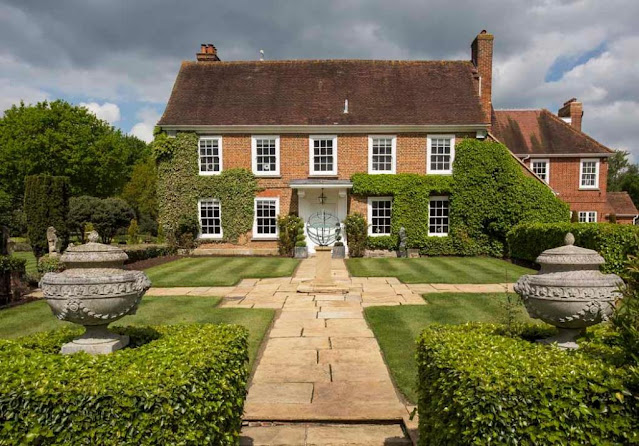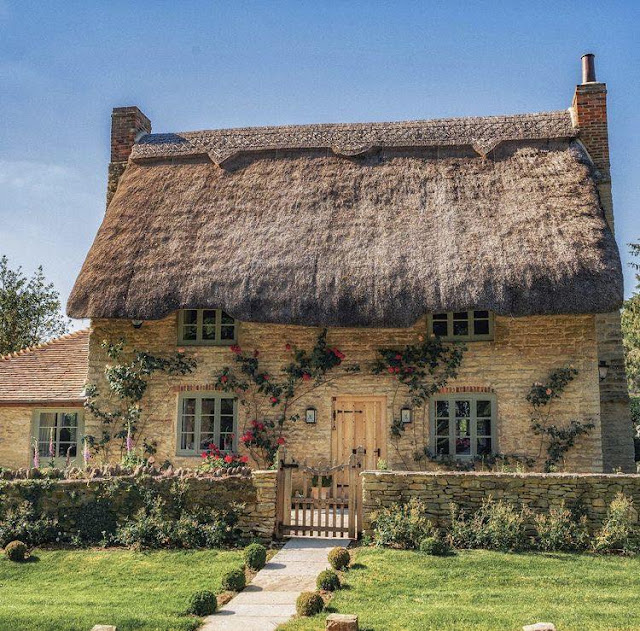History, History, History...
The striking Priors Hall is a country home bursting with history near village of Stebbing, Essex
Currently on the market with estate agent's Knight Frank for £2,900,000 (correct as of 05/01/2022) |
| Priors Hall |
In its present form Priors Hall dates from about 1400, below is an extract from the Stebbing Local History Society:
When the Normans arrived in 1066 the village had probably been in existence for three or four hundred years and was held by Siward, a Saxon thegn. It is almost certain that by this time the settlement pattern of housing and fields were already established. By 1086 two Norman Lords, Henry de Ferrers and Ranulf Peverell are recorded in Little Doomsday as holding the village between them. The de Ferrers family initially prospered, indeed there is evidence that in the 14th century William, Lord Ferrers, made Stebbing his family home and that somewhere in the village there existed a great house fit for a noble family.
Entrance Hall
Earlier, in 1181, William de Ferrers 3rd Earl of Derby gave the Church and it lands, part of his Stebbing holding, to the Knights Hospitallers where it remained until their dissolution in 1540. It then became known variously as Friars (Freers) or Priors Hall.
In the late 13th and early 14th centuries the manor of Porters Hall was built up by the local Porter family, but by the 16th century its lands had passed to the Earls of Essex, (who already held the manor of Stebbing Hall), although Porters Hall continued to function as a separate manor administering it’s manorial rights until the early 20th century. So, when our yeoman was taking his walk in the 16th century there were three Manors: Stebbing Hall, Porters Hall and Priors Hall. The Capel family, Earls of Essex, continued to be major landowners in the parish until 1901 when they sold their Stebbing estates. Priors Hall was separately owned.
credit: https://stebbinglhs.wordpress.com/stebbing-history/
 |
| Dining Room |
NOTES: This hall house, one of the three former manor houses of Stebbing, is an example of a timber-framed house with wattle and daub infilling. The hall was built c.1400, its roof raised c.1490, and rebuilt c.1600. The rear range, originally a separate late 15th century structure, was incoporated into the main builing in the 20th century.
 |
| Billiard/Snooker Room |
 |
| Drawing Room |
 |
| Leisure Suite |
 |
| Kitchen |
 |
| Garden Room |
 |
| Bedroom |
 |
| Bedroom |
 |
| Bathroom |
 |
| Grounds |
"Lord of the Manor"
The current "Lord of the Manor" has undertaken extensive research and produced the following information:The land formerly associated with the Manor of Prior's Hall is in the village of Lindsell, five kilometres north of Great Dunmow, Essex, about halfway between London and Cambridge. The name Lindsell is believed to mean "hut among the lime trees."
The present Lord of the Manor of Prior's Hall, Lindsell, is Stephen Lautens, GCJ, B.A., J.D.
The parish of Lindsell consisted of three manors: Prior's Hall (spelled with a wandering apostrophe throughout the ages as "Prior's", "Priors' " or simply "Priors"), Lindsell Hall and Lashley Hall. The lands of Prior's Hall, Lindsell and nearby Prior's Hall, Widdington were part of an estate administered as a single unit since before the Norman Conquest (1066 A.D.). In the Domesday Book they were recorded as being held by a freeman named Thorkell at the time of Edward the Confessor. At the time of Domesday the Lindsell area was, as it is now, a small, thinly-populated group of hamlets. Lindsell has had a long history as an inhabited place, illustrated by the Roman bricks built into the ancient church of St Mary the Virgin and a large hoard of silver Roman coins discovered in nearby Widdington in 1830.
Prior's Hall, Lindsell gets its name from the Priory of St. Valery-sur-Somme in Picardy to which it was given by William the Conqueror. Following the Conquest King William I granted Prior's Hall Manor, Lindsell to the Priory of St. Valery-sur-Somme, Picardy, for the “spiritual help” its Benedictine monks provided in the form of prayers to reverse an unfavourable wind for sailing during his invasion and conquest of England in 1066. The story is told in the 1907 A History of the County of Essex: Volume 2:
"When the Norman fleet was prepared for the invasion in 1066, it lay for a fortnight at the mouth of the Somme waiting for a favourable wind. Prayers were offered up at the abbey of St. Valery, and at last the monks brought out in solemn procession the shrine containing the body of the saint. The blowing of the south wind on Wednesday, 27 September, was piously ascribed to this, and there can be no doubt that the grants made to the abbey in England, whether by the Conqueror or others, were intended as a thank-offering."
The Domesday Book of 1086 records an administrator named Eudo the Steward who was responsible for not only Prior's Hall but many other manorial possessions, which he must have visited on a circuit to collect rents, taxes and manage. In 1086 the recorded valuable assets of the village consisted of "a Mill and 5 Beehives" and was set down in the Domesday Book census.
As tithes and fees were paid to the owners, lands in foreign ownership became an increasing drain on the English economy. Intermittent war with France labelled them "alien priories" and they were subject to restriction and confiscation by the Crown. Prior's Hall and nearby Widdington was confiscated by Edward III and in 1377 given to William of Wykeham, the Lord Chancellor of England and Bishop of Winchester. In 1379 William of Wykeham founded New College, Oxford, and conveyed the Manor of Prior's Hall, Lindsell, along with a number of other manorial properties, to New College as a source of timber for construction as well as revenue. This appears in the Patent Rolls of Richard II on March 10, 1391, referring to it by its older name "the manor of... Lyndesell called Seint Waleries".
New College, Oxford, held title to Prior’s Hall Manor, Lindsell for the next 600 years. In the mid-1800s to the early 1900s, New College sold several of the nearby manorial properties. The land belonging to the Manor of Prior's Hall, Lindsell, was sold by New College in 1923. It held its last manorial court there in 1912. After selling the real property of Prior's Hall in 1923, New College retained ownership of the title or dignity “Lord of the Manor of Prior's Hall, Lindsell”, which it eventually sold in an auction of 16 Lordships of the Manor offered to “Old Boys” of New College, Oxford in early 1994, when it was purchased by the previous Lord of the Manor.
Today there remains the heritage building and operating church of St Mary the Virgin, Lindsell, which stands in the middle of the parish. It is built of flint and pebble rubble, with an ancient Norman tower being partly brick with dressings of limestone, dating back to the 12th century. The chancel and the opening to an anchorite cell on its north wall are from the 13th century as is the east window, which still contains beautiful fragments of original glass from the 1200s. The font dates from the 15th century.
Another heritage site from the area is the nearby Prior’s Hall Barn, one of the finest surviving medieval barns in the east of England. The "Prior's Hall" referred to is in the Manor of Prior's Hall, Widdington, another manor originally also owned by the same Priory of St. Valery-sur-Somme, Picardy, which also ultimately became the property of New College, Oxford. The barn is built of oak and originally was constructed of some 900 separate pieces of unseasoned timber. The original massive barn used no iron nails or strapping. Tree ring dating shows that timbers were felled between 1417 and 1442, when the area was thick with valuable old growth forest. The barn was constructed at the direction and for the benefit of its new owners, New College, Oxford, to store the produce of the College's Essex estates. The Manor of Prior's Hall, Widdington, also has a surviving manor house, which may be the oldest continually inhabited building in England, as recent renovations discovered what appears to be walls of an Anglo-Saxon chapel from the 10th century.
From Brazen Head, a hamlet in northwest Lindsell a short distance from Prior's Hall, comes what is considered the greatest moveable treasure from the area - a doorknob cast in bronze that dates to the 1300s. The hamlet is believed to have taken its name from the lion's head door ring (shown in the top corner of this page), which remained on the door until 1980. In 1990 it was donated to the British Museum where it remains on display.
source: www.priorshallmanor.co.uk
Country Life Magazine has produced a charming article about Priors Hall... read more
 |
| Grounds & View |
Photo credit: Knight Frank







Comments
Post a Comment